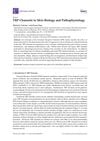Expanding The Phenotypic Spectrum Of Olmsted Syndrome
June 2015
in “
Journal of Investigative Dermatology
”
TLDR TRPV3 gene mutations cause Olmsted syndrome symptoms, but severity varies.
The study expanded the understanding of Olmsted syndrome (OS) by identifying heterozygous missense mutations in the TRPV3 gene in six families, including two novel mutations, p.Gly573Cys and p.Gly568Val. These mutations were linked to symptoms such as painful palmoplantar keratoderma, alopecia, and hyperhidrosis, although with less severity than typical OS. The research underscored the genetic heterogeneity of OS and the significant role of TRPV3 mutations in its pathogenesis. It also suggested that environmental factors or modifier genes might influence the variability of symptoms, highlighting the importance of considering TRPV3 mutations in diagnosing painful palmoplantar keratoderma.


